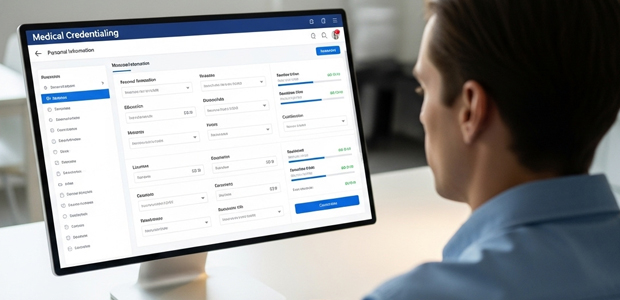Medical credentialing remains one of healthcare’s most difficult administrative challenges. The right software can transform this burden into a streamlined process, but selecting the wrong platform leaves organizations drowning in credentialing inefficiency. Understanding your specific credentialing tasks forms the foundation for making an informed software choice.
Know Your Credentialing Workload
 Before diving into software features, organizations must assess their current credentialing situations. Small practices handling 10-15 providers annually face entirely different challenges than large health systems managing thousands of applications. Rural hospitals often struggle with limited staff resources, while urban medical centers deal with high-volume processing and multiple specialties.
Before diving into software features, organizations must assess their current credentialing situations. Small practices handling 10-15 providers annually face entirely different challenges than large health systems managing thousands of applications. Rural hospitals often struggle with limited staff resources, while urban medical centers deal with high-volume processing and multiple specialties.
Your provider mix also matters a lot. Primary care physicians typically require straightforward verification processes, while specialists like neurosurgeons or interventional cardiologists demand extensive documentation.
Locum tenens providers create unique challenges with their temporary status and multiple facility requirements.
Volume Considerations Shape Software Needs
Most credentialing teams underestimate their true workload. A single provider application touches dozens of verification points. Such as medical school transcripts, residency confirmations, board certifications, license validations, malpractice history, hospital privileges, and reference checks. Each verification point requires follow-up, documentation, and often re-verification when documents expire or become outdated.
Core Task Categories That Drive Software Selection
Primary Source Verification
This foundational task consumes the most time in traditional credentialing workflows. Manual verification involves contacting medical schools, residency programs, licensing boards, and certification organizations individually. The process typically takes weeks or months, depending on response times from various institutions.
- CredyApp addresses this bottleneck through automated verification systems that maintain direct connections with over 6,000 primary sources. The platform pulls verification data electronically from medical schools, licensing boards, and specialty certification organizations. Their system covers 95% of U.S. medical schools and maintains real-time connections with all 50 state medical boards.
- Medallion offers another approach with NCQA-certified automation that generates committee-ready files in as little as three days. The platform specializes in accelerating provider credentialing while maintaining compliance standards, making it particularly attractive for organizations prioritizing speed and regulatory adherence.
- For organizations dealing with international providers, IntelliCentrics provides specialized verification services for foreign medical graduates. Their platform includes connections to international medical schools and credential evaluation services, addressing a gap many domestic-focused platforms miss.
Document Management and Storage
Healthcare organizations generate massive volumes of credentialing documents. A typical provider file contains 200-300 pages of documentation, and these files multiply across your entire provider network. Traditional paper-based systems create storage nightmares, while basic digital storage lacks the organization needed for efficient retrieval.
 symplr Provider transforms document chaos into organized, searchable repositories through intelligent document recognition that automatically categorizes and files incoming documentation. The platform uses optical character recognition to make scanned documents fully searchable and tracks document expiration dates with automatic renewal reminders.
symplr Provider transforms document chaos into organized, searchable repositories through intelligent document recognition that automatically categorizes and files incoming documentation. The platform uses optical character recognition to make scanned documents fully searchable and tracks document expiration dates with automatic renewal reminders.- MD-Staff takes a different approach, offering cloud-based document storage with robust security features designed specifically for healthcare compliance. The system includes audit trails, version control, and role-based access controls that meet HIPAA requirements while providing easy document retrieval.
- PreCheck specializes in document collection and management, offering provider-facing portals where applicants can upload documents directly. The system automatically validates document completeness and formats, reducing administrative burden on credentialing staff.
Workflow Automation and Task Management
Credentialing involves numerous sequential steps that must be completed in specific orders. Traditional manual processes rely on paper checklists, spreadsheets, or basic task management tools. These approaches create opportunities for missed steps, delayed processes, and inconsistent quality.
- CPSI Credentialing & Privileging creates automated workflows that guide users through each step while tracking progress in real-time. When a verification is completed, the system automatically moves to the next required task. The platform supports parallel processing where possible, initiating multiple verification streams simultaneously to reduce overall processing time.
- Silversheet focuses specifically on workflow optimization for credentialing committees. The platform manages committee schedules, distributes applications for review, and tracks approval statuses through complex multi-step processes. Their system integrates with hospital information systems to automatically update provider privileges upon approval.
Specialized Requirements by Organization Type
Hospital Systems
Large hospital networks face unique credentialing challenges that smaller organizations never encounter. Multiple facilities often require separate credentialing processes, even for the same provider. Different departments may have varying documentation requirements. Credentialing committees meet on different schedules across facilities.
- Modio Health (formerly MedTrainer) includes multi-facility management capabilities designed for health systems. The platform tracks a single provider’s status across multiple locations while maintaining facility-specific requirements. Their system supports complex approval workflows that route applications through appropriate committees and administrative channels.
- Cactus excels in hospital environments with features specifically designed for medical staff offices. The platform manages medical staff bylaws, handles privileging decisions, and maintains detailed audit trails required for Joint Commission compliance. Their committee management tools coordinate multiple review processes across different hospital departments.
Ambulatory Surgery Centers
ASCs face unique credentialing pressures due to their specialized nature and often limited administrative staff. These facilities typically handle high-volume, short-term credentialing for visiting surgeons while maintaining core staff privileges.
 ASC Credentialing was built specifically for ambulatory surgery centers, offering streamlined processes for temporary privileges and visiting physician credentialing. The platform includes templates for different surgical specialties and automated workflows that account for ASC-specific regulatory requirements.
ASC Credentialing was built specifically for ambulatory surgery centers, offering streamlined processes for temporary privileges and visiting physician credentialing. The platform includes templates for different surgical specialties and automated workflows that account for ASC-specific regulatory requirements.- OperateSmart represents SIS’s approach to providing ambulatory surgery centers with integrated software and services that enhance operational efficiency, clinical documentation, and financial performance, enabling ASCs to streamline workflows from scheduling and patient engagement through billing and inventory management within a single, end-to-end technology platform.
Medical Groups and Clinics
Smaller medical practices often struggle with credentialing software designed for large organizations. These practices need powerful functionality without the complexity and cost of enterprise-level systems.
- ProCredEx provides another practice-friendly option with scalable pricing based on provider volume. The platform includes primary source verification, document management, and basic workflow automation suitable for practices managing 20-100 providers.
Insurance and Payer Enrollment Integration
Modern credentialing extends beyond hospital privileges to include insurance network participation and Medicare/Medicaid enrollment. Managing these parallel processes creates additional complexity that specialized software can address.
- Availity serves as a comprehensive provider enrollment platform that handles insurance credentialing across multiple payers. The system maintains connections with major insurance companies and government programs, allowing providers to complete multiple applications through a single interface.
- Council for Affordable Quality Healthcare (CAQH) ProView provides a centralized database where providers maintain their credentialing information. Insurance companies and healthcare organizations can access this verified information, reducing redundant data collection and verification processes. At Medwave, we’ve created a CAQH ProView form to make this much easier on providers and groups.
- ProviderTrust combines traditional credentialing with ongoing monitoring services. The platform continuously monitors provider credentials for changes or issues, alerting organizations to potential problems before they impact operations or compliance.
- Companies like CureMD provide affordable insurance credentialing solutions to expedite provider onboarding, focusing specifically on the payer enrollment aspect of credentialing workflows.
Implementation and Integration Considerations
Electronic Health Record Integration
Most healthcare organizations use electronic health records systems that should integrate seamlessly with credentialing software. Poor integration creates duplicate data entry and increases error risk.
- Epic MyChart includes basic credentialing functionality for Epic users, though many organizations find it insufficient for complex credentialing needs.
- Third-party solutions like symplr Provider offer robust Epic integration, synchronizing provider data between systems while maintaining specialized credentialing capabilities.
- Cerner users often choose CPSI for its native Cerner integration capabilities. The platform can automatically update provider privileges in the EHR system upon credentialing completion, eliminating manual data synchronization.
Legacy System Migration
Organizations moving from paper-based or outdated digital systems face significant data migration challenges. Historical credentialing files contain years of documentation that must be preserved for compliance and reference purposes.
- IntelliCentrics provides migration services that digitize paper files and transfer data from legacy systems. Their team handles document scanning, data extraction, and system setup to minimize disruption during transitions.
- PreCheck offers similar migration support with additional services for cleaning and organizing historical data. Their process includes quality checks to ensure migrated information maintains accuracy and completeness.
Cost Considerations and ROI
Pricing Models
Credentialing software pricing varies dramatically based on features, provider volume, and service levels. Understanding different pricing approaches helps organizations budget appropriately and avoid unexpected costs.
- Per-provider pricing is common among platforms targeting smaller organizations, making costs predictable and scalable. These models typically range from $15-50 per provider per month depending on features included and automation levels.
- Enterprise licensing works better for large organizations with hundreds or thousands of providers. Platforms like symplr offer volume discounts that can significantly reduce per-provider costs for large health systems.
- Service-based pricing includes human verification services along with software access. CredyApp offers comprehensive management and control solutions that can include outsourced verification tasks for organizations wanting to reduce internal administrative burden.
Return on Investment Metrics
Calculating credentialing software ROI requires understanding current process costs and potential savings. Most organizations underestimate the true cost of manual credentialing processes.
Administrative staff time represents the largest cost component. Manual credentialing typically requires 15-25 hours per provider application. At average healthcare administrative wages, this represents $300-500 in labor costs per application before considering benefits and overhead.
Software automation can reduce this time by 60-80%, creating immediate labor savings. Additional savings come from faster processing times that get providers working sooner, reducing revenue delays from credentialing backlogs.
Technology Trends Shaping the Future
Artificial Intelligence Integration
AI-powered credentialing solutions are becoming standard, delivering more dependable outcomes for enhanced patient safety. These systems can automatically identify potential issues, predict processing timelines, and optimize verification workflows.
Blockchain and Digital Certificates
Blockchain-powered platforms for issuing digital certificates are emerging, with solutions like Certif-ID providing blockchain-based credentialing platforms that offer enhanced security and verification capabilities.
Market Growth and Competition
The market for credentialing solutions is growing rapidly, with companies like Symplr, Verity, IntelliSoft, and MedTrainer competing to offer the most sophisticated platforms. This competition drives innovation and provides organizations with increasingly powerful options.
Making the Final Decision

Selecting credentialing software requires matching specific organizational needs with platform capabilities. Organizations should evaluate software based on their primary pain points rather than trying to find platforms with every possible feature.
Small practices struggling with basic verification tasks may find SimplyCred or ASC Credentialing perfectly adequate. Large health systems managing complex multi-facility credentialing typically need enterprise platforms like symplr Provider or CACTUS.
The most successful implementations result from clear understanding of current processes, realistic assessment of needed improvements, and careful platform evaluation that prioritizes essential capabilities over feature quantity. Taking time to properly assess needs and evaluate options ultimately leads to better software selection and more successful credentialing operations.
Summary: Choose the Right Medical Credentialing Software
Choosing the right medical credentialing software requires matching your organization’s specific tasks with the appropriate technological solutions. From primary source verification platforms like CredyApp and IntelliCentrics to document management systems like symplr Provider and MD-Staff, each software addresses distinct credentialing challenges. Hospital systems need multi-facility capabilities found in CACTUS and Modio Health, while smaller practices benefit from streamlined solutions like SimplyCred and ProCredEx.
![]()
Success depends on understanding your credentialing workload, identifying key pain points, and selecting platforms that address your most critical needs rather than pursuing feature-heavy solutions that may overwhelm your team.
Medwave brings years of hands-on experience with these credentialing platforms to help healthcare organizations navigate software selection and implementation. Having utilized many of these tools internally for our own credentialing operations, we understand their strengths, limitations, and optimal applications.
Our team can facilitate software licensing negotiations, provide implementation guidance, and offer ongoing support to ensure your chosen platform delivers expected results.
We work with healthcare organizations to assess their specific credentialing challenges, recommend appropriate software solutions, and provide the expertise needed for successful deployment and optimization.
Contact us to handle all of your medical credentialing software needs and/or challenges.



 ASC Credentialing was built specifically for ambulatory surgery centers, offering streamlined processes for temporary privileges and visiting physician credentialing. The platform includes templates for different surgical specialties and automated workflows that account for ASC-specific regulatory requirements.
ASC Credentialing was built specifically for ambulatory surgery centers, offering streamlined processes for temporary privileges and visiting physician credentialing. The platform includes templates for different surgical specialties and automated workflows that account for ASC-specific regulatory requirements.